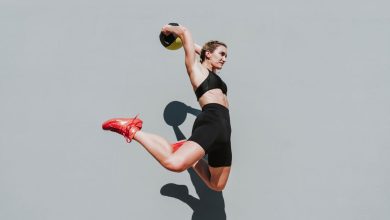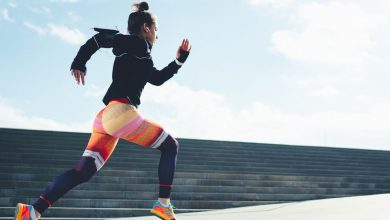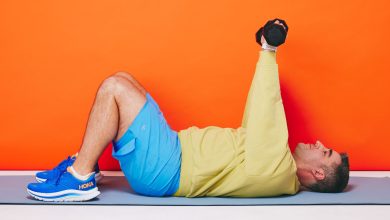3 Must-Try Takeaways From Megan Thee Stallion’s Abs Workout, According to a Trainer

Sure, Megan Thee Stallion is most famous for her musical talents, but the Grammy-award winning rapper can also bring it in the gym.
In a video shared with her 32.7 million Instagram followers over the weekend, Megan highlighted snippets of her workout program with new boyfriend-slash NBA star Klay Thompson. And while the accompanying commentary was humorous (“we had to do these goddamn Russian twist ball thingamajigs” Megan quipped when describing the core exercise), the overall routine was no joke. It featured 10 different exercises—including some super advanced ones, like ab wheel rollouts, planks with alternating leg and arm lifts, and split squats with a single-arm overhead press—that together smoke pretty much every muscle group.
“She’s obviously killing it in this workout,” Katie Pierson, CPT, a Montana-based certified personal trainer and contributor at Indoor Cycling Love, tells SELF. But the video doesn’t just emphasize Megan’s impressive strength; it also highlights some pretty awesome fitness principles that anyone can benefit from—particularly if you feel like your ol’ standby abs routine is getting a little, shall we say, stale.
Here are three takeaways to maximize your core workouts, according to Pierson, that are worth incorporating into your own gym seshes.
1. There are tons of different ways to train your core—and no, it’s not just about “abs exercises.”
While the workout Megan shared was a full-body routine, there was a clear emphasis on core activation, Pierson says.
But a workout stacked with sit-ups, this was not: She targets her entire core with a bunch of different movement patterns. And that’s key to well-rounded strength in the gym—and functional fitness outside—of it, since it preps you to better handle a wide variety of scenarios you may encounter in daily life, including hauling a heavy box without stressing your back, twisting your torso to put groceries on your counter, and staying upright when your dog barrels into your knees.
Let’s take a closer look: The Russian twists engage her core through dynamic movement with rotation, which especially fires up the obliques (muscles on the sides of the torso). The static plank works the core isometrically (no movement at all!) since the goal there is to hold as still as possible; in this case, muscles like the transverse abdominis (deep core muscle that wraps around your spine and sides) have to really fire to keep her steady and prevent her hips from drooping. The plank with alternating arm and leg lifts is an example of an instability challenge. By removing a base of support, this requires her core to work extra hard to hold steady.
But it’s not just about “abs exercises,” either: Megan incorporated compound exercises like the sled push, hex bar squat, and split squat with single-arm overhead press. While you might think of these more as lower-body exercises—they certainly do smoke your legs and glutes—your core is actually a huge player here. Those muscles need to fire to stabilize her spine while her limbs move to push that heavy load.
“She’s really fatiguing her muscles in different ways and changing the training stimulus,” Pierson says. And that variety is something to emulate. That’s because “if you’re doing just one type of movement, your body is going to adapt,” Pierson explains. And when it adapts, it won’t continue to get stronger, since it’s no longer challenged. That’s why training your core in a bunch of different ways, as Megan does, is beneficial if you want long-term results.
This type of comprehensive core training is also key for helping that muscle group work together as one unit, Pierson adds. Your core isn’t just your abs, or your rectus rectus abdominis, the muscles that run horizontally across your abdomen—it incorporates your lower back muscles, too. And to have the sturdiest, most functional core possible, you need both front and back to be strong. (If there’s an imbalance between the two, you run the risk of pain, injury, and decreased performance, Pierson says.) So rather than only doing moves that primarily home in on the abs (like sit-ups or crunches), it’s important to incorporate exercises that train your entire core.
2. Adjusting exercises to your level is key.
There are a few instances in the video where Megan tweaks exercises so that they are doable for her: Modifications are huge, since they allow you to keep your form on point, which is key to getting the benefits of the exercise. As Pierson explains it, you want to “make sure that your form is on point so you don’t injure yourself and you’re getting the most out of your workout.”
Take the ab wheel rollouts: That exercise is “an advanced move,” Pierson says. When doing them, it’s important to keep your spine in neutral alignment rather than letting it arch; otherwise you could strain your lower back, she explains. Maintaining that alignment requires a lot of core strength, and it becomes harder to do the farther you roll out the wheel. So if you’re new to the exercise, take a cue from Megan: She reduces her range of motion, stopping part-way before reversing the movement. This is a key mod, since it allows her to do the move without letting her hips sag or lower back arch.
Then there’s a pull-up, another super advanced exercise that, yep, smokes your back and biceps, but also really fires up your core, too. Megan uses a band (and her boyfriend as a spotter) to complete it.
With the pull-ups, “I love that she’s using the band for those,” Pierson says. (The band makes the exercise easier by reducing some of your bodyweight, so there’s less heft for you to pull up.) This assistance “removes the barrier of entry” for pull-ups, Pierson says, and makes this challenging, oftentimes intimidating exercise more accessible.
3. The cooldown is a can’t-skip step to any kind of strength workout.
The video ends with Megan and Klay cooling down: Megan helps Klay perform a hamstring stretch and a variation of the happy baby stretch. The cooldown, Pierson says, is a part of the workout that “a lot of people miss.” It can seem like a skippable component, especially for exercisers who are short on time or those who think movement needs to leave them sweaty and aching to be worthwhile. But taking a few minutes for gentle movement and stretching post exercise is important on several fronts.
For one, regular stretching can help improve your range of motion, which ultimately helps you get more out of your workouts, Pierson explains. That’s because the more range of motion you have, the more muscle you can activate and the more strength you’ll eventually gain. Plus, stretching after a workout increases blood flow, boosts oxygen levels, and delivers nutrients to your body and your muscles, which aids with the recovery process.
Then there’s the fact that the cooldown is a great way to calm your body and mind post exercise, helping you end your workout on a feel-good note. And that can cultivate a positive association with exercise that spurs you to make it a regular habit. Along with a stellar pump-up playlist (might we suggest Megan’s 2024 namesake album?), that may be all the motivation you need to crush your gym goals.
Related:
- 6 Reasons to Work Your Core That Have Nothing to Do With ‘Getting Abs’
- What Exactly Is Your ‘Deep Core’—and How Do You Strengthen It?
- What Does ‘Activate Your Core’ Even Mean?
Get more of SELF’s great fitness coverage delivered right to your inbox—for free.



